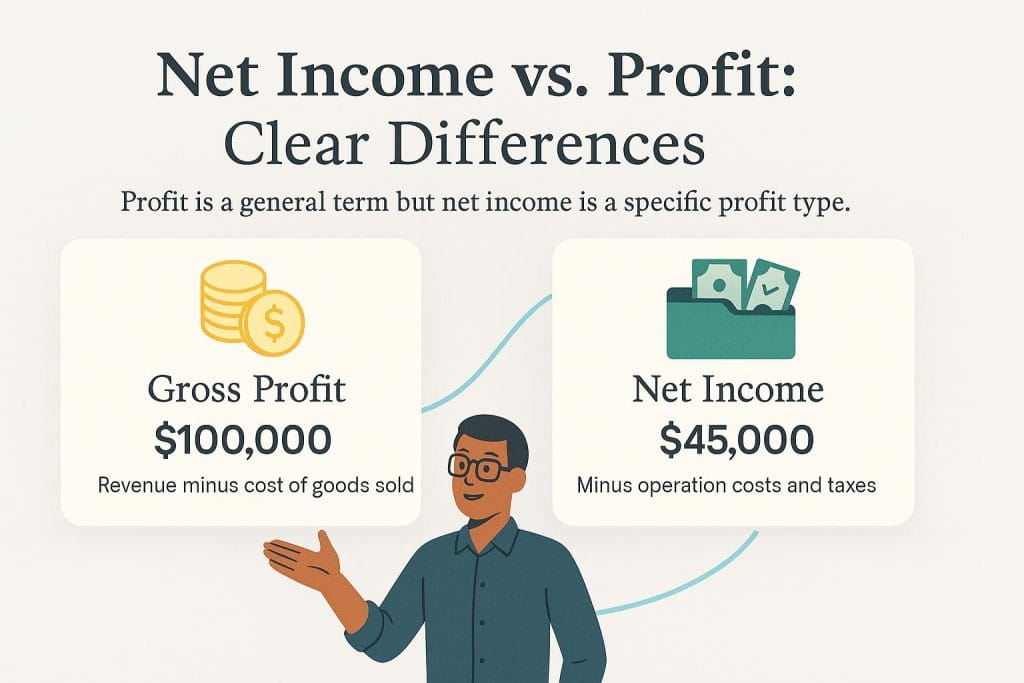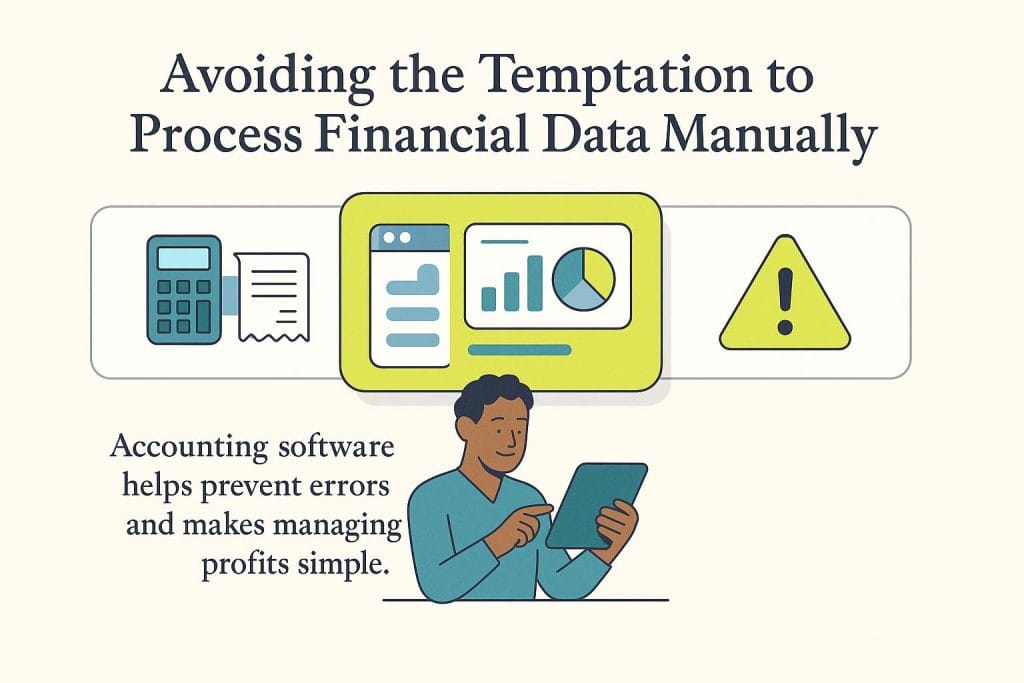Business.com aims to help business owners make informed decisions to support and grow their companies. We research and recommend products and services suitable for various business types, investing thousands of hours each year in this process.
As a business, we need to generate revenue to sustain our content. We have financial relationships with some companies we cover, earning commissions when readers purchase from our partners or share information about their needs. These relationships do not dictate our advice and recommendations. Our editorial team independently evaluates and recommends products and services based on their research and expertise. Learn more about our process and partners here.
What’s the Difference Between Net Income and Profit?
Understanding how these two terms differ will help you measure how well your business is doing and allow you to express that appropriately.

Table of Contents
Financial success is the goal of every business owner, but tracking it isn’t always straightforward. Many business owners look at their profit and assume they know how well their company is doing, but that number doesn’t always tell the whole story. In particular, terms like “net income” and “profit” are often used interchangeably when they actually mean different things.
Understanding the difference between the two is essential if you want to communicate your business’s financial results accurately and make smarter decisions. We’ll break down what profit and net income really mean, how they compare, and why knowing the difference matters for your bottom line.
Why understanding net income vs. profit matters
It’s easy to confuse profit and net income, especially when you’re focused on sales. Sales show what’s coming in, and increasing sales is a natural goal for business owners. But sales alone don’t reveal how much of that money actually stays in the business. Profit offers part of the picture, while net income shows what truly remains once every expense is covered.
Knowing the difference between net income and profit helps you:
- Explain your company’s results clearly to lenders, business investors and employees.
- Make realistic decisions about how much money to reinvest or take home.
- Catch early warning signs of financial trouble before they grow.
Cassandra Gucwa, founder and CEO of Minerva Digital, learned this firsthand: “When I started my business, I thought it was doing well when I saw the gross income.” But once she looked at net income after all expenses, she came back down to earth.
Her story shows how strong sales or gross profit can be misleading if you don’t look at the bottom line.
What is net income?
Net income, also called net earnings or net profit, is the amount your business keeps after subtracting all expenses, including operating costs, loan interest, business taxes and one-time charges. It’s often called the “bottom line” because it sits at the end of the income statement.
Here’s the basic formula:
Total revenue – total expenses = Net income
Unlike sales or partial profit measures, net income reflects the full financial picture of your business. It accounts for:
- Day-to-day operating expenses
- Loan interest payments
- Taxes
- Amortization or depreciation of company assets
- One-time charges or gains (such as selling equipment)
Because it’s calculated after everything is deducted, net income is one of the best indicators of your company’s true financial standing. Tracking it consistently lets you compare results period over period and see whether your business is growing, holding steady or falling behind.
What is profit?

Profit is the money your business makes after subtracting certain expenses. Unlike net income, which always reflects all expenses, “profit” can describe earnings at different stages. That’s why the term can be confusing — it’s a broader category, not just one number.
On an income statement, you’ll usually see three main types of profit:
- Gross profit: Revenue minus the cost of goods sold (COGS). This shows how efficiently you produce or source what you sell, but it doesn’t include operating expenses.
- Operating profit: Gross profit minus operating expenses like payroll liabilities, rent, utilities and other overhead costs. This measures how well your core operations are performing.
- Net profit (net income): Operating profit minus taxes, interest and all other expenses. This is the bottom line — the amount your business actually keeps.
Each type of profit offers a different view of performance. For example, strong gross profit but weak net income may signal that non-production costs are cutting into results. Looking at all three together gives you a layered, realistic picture of your company’s health. (And remember: net income will almost always be lower than gross profit, since it includes every category of expense.)
Analyzing profitability in your business
Understanding the difference between gross, operating and net profit is only the first step. To see how your business is really performing, you also need to measure those numbers relative to sales, and that’s where profit margins come in.
For example, the gross profit margin shows how efficiently you produce or source what you sell. The formula is simple:
Gross profit ÷ Net sales = Gross profit margin
If you sell a product for $8 that costs $6 to make, your gross profit is $2, and your gross profit margin is 25 percent. In other words, for every dollar in sales, 25 cents is left after covering production costs.
However, Chris Sorensen, CEO of PhoneBurner, cautions against looking only at gross profit. “You might see sales increasing, but if operational costs are also rising, profitability as a whole will likely remain stagnant,” Sorensen explained. Many business owners invest heavily in marketing or infrastructure based on gross revenue, only to find themselves squeezed when overhead or fulfillment costs climb.
That’s why it’s critical to also track operating profit, which shows how well you’re managing expenses like rent, salaries and marketing, and net income, which reveals the bottom line after every cost, including taxes and interest.
By monitoring each type of profit over time, you can spot where money is being lost, adjust pricing and expenses, and benchmark your performance against others in your industry.
Example of net income vs. profit

It’s one thing to define profit and net income, but seeing the numbers side by side makes the difference clearer.
Suppose Company Z reports a gross profit of $100,000 — revenue minus the cost of goods sold. But after subtracting operating expenses, taxes and interest, the company’s net income is $45,000. That’s the true bottom line: the money the business actually keeps once every expense is covered.
What to do if your profits fall short
Even with strong sales, many small businesses are surprised to see profits fall short of expectations. Hidden expenses, rising overhead and underpriced products can quietly eat away at the bottom line.
Gucwa learned this firsthand after an unsuccessful email marketing campaign yielded a disappointing digital marketing ROI. “We invested about $25,000 in email marketing, and our return on investment was much lower than that of other marketing channels,” Gucwa recalled. However, by shifting strategies and trimming costs elsewhere, her company boosted its net profit.
Pricing can also be a silent culprit. Gucwa recalled a friend selling on Etsy who saw steady sales but almost no profit because prices didn’t reflect the true costs of running the business — a common pitfall for new entrepreneurs eager to attract customers.
Michael Bush, co-founder of GrowthWays Partners, says business owners should focus on three areas when profits lag:
- Gross margin: Bush advises looking for ways to improve efficiency, negotiate better supplier terms or adjust pricing.
- Expenses: Scrutinize your spending to cut business costs without stalling growth. Marketing campaigns and travel are common places to find savings.
- Cash flow: Keeping a close eye on your cash position is a common accounting challenge. “Cash tells the real story,” Bush noted. “If you’re consistently running low, something needs to change.”
The good news? Profitability issues don’t mean your business is doomed. By reviewing your margins, tightening expenses and monitoring cash flow, you can make course corrections before small leaks sink the ship.
Don’t rely on spreadsheets alone

Many small business owners start out tracking finances in a spreadsheet. It feels quick and affordable, but the risks add up fast. Missed entries, inconsistent records and late reconciliations can leave you guessing about your company’s true performance.
Gucwa discovered this the hard way: “I had no idea what my net income was. I only found out how profitable my business was when I compiled information for my taxes.” After switching to QuickBooks and hiring an accountant, she finally gained a real-time view of her company’s financial health.
Automation makes that difference even clearer. “Automated reports that show real-time net income, versus only projections, have really helped us make more informed decisions on various aspects of the business — hiring, pricing, reinvesting,” Sorensen explained.
The best accounting software does more than crunch numbers. It delivers instant insights, helps you spot trends and lets you act before problems grow. That kind of visibility can mean the difference between making smart, timely decisions and discovering too late that profits aren’t where they should be.
Dachondra Cason contributed to this article.








